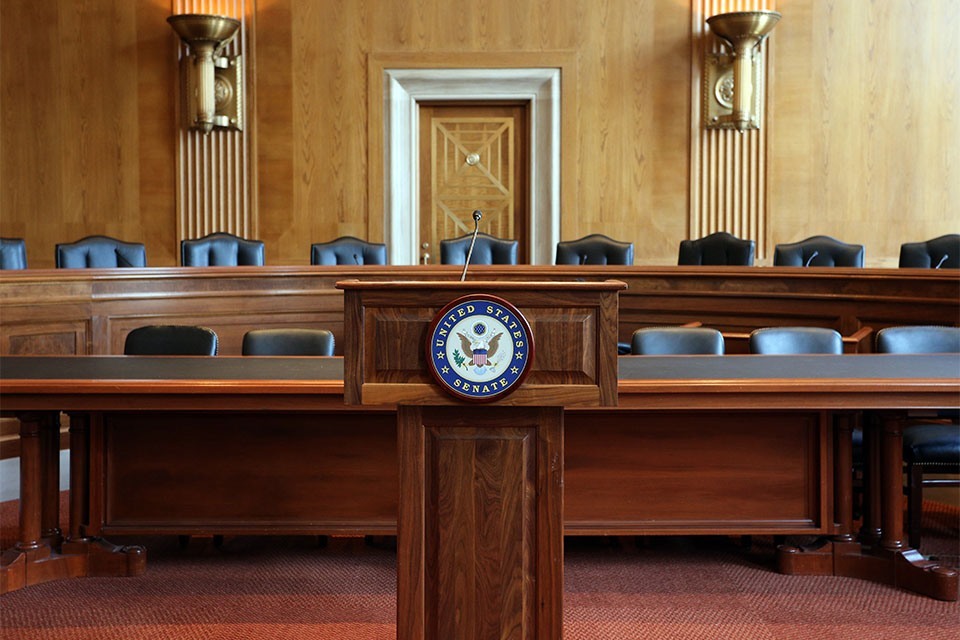Letter Published April 13, 2021 · 11 minute read
Workforce Policy Ideas for the 117th Congress
Sergio Galeano & Gabe Horwitz

At the end of March 2021, the Senate Health, Education, Labor, and Pensions (HELP) Committee requested input from stakeholders on policy ideas on workforce development. In response, Third Way submitted the following letter.
April 8, 2021
The Honorable Patty Murray
The Honorable Richard Burr
Senate Health, Education, Labor, and Pensions Committee
428 Dirksen Senate Office Building
Washington, DC 20510
Dear Chairwoman Murray and Ranking Member Burr,
Thank you for the opportunity to submit comments in advance of the Committee’s consideration of bipartisan solutions to update and expand workforce training programs. Your request could not be more timely—although a nationwide vaccination effort has improved public health projections, the post-pandemic economy presents continued challenges for America’s workforce. While some workers and industries are positioned to experience a broad recovery, the livelihoods of countless others are under threat of upheaval. Automation, artificial intelligence, and related technological advancements have chipped away at jobs across numerous industries for years. Over the past year, the pandemic has forced millions of businesses to shut down permanently, leaving a significant void in the labor market. According to McKinsey, job displacement during the pandemic will force over 17 million Americans to find new occupations.
Given this dim economic situation, we need bold solutions to revamp our workforce development system and usher in new opportunities for all workers, no matter who or where they are. Below, we recommend seven overarching ideas that do just that. We look forward to working with you and the entire Committee as you advance legislation in this space.
1. Expand apprenticeships in every state through Apprenticeship Institutes and new Apprenticeship Block Grants.
Apprenticeships can play a critical role in our economic recovery and help people regain their footing in the job market—especially among industries and areas that have seen widespread changes. In order to dramatically expand the number of apprenticeships across the country, we recommend the creation of Apprenticeship Institutes (also known as hubs or intermediaries) in every state. These institutes will serve as hubs, actively engaging everyone needed to make apprenticeships a reality—workers, employers, educators, unions, and community partners.
This idea was featured in the House-passed National Apprenticeship Act—an effort we strongly support—and builds off the Apprenticeship Hubs Across America Act sponsored by Senators Chris Coons (D-DE) and Todd Young (R-IN) and Reps. Donald Norcross (D-NJ) and David McKinley (R-WV). The Committee may also want to consider expanding Apprenticeship Institutes by creating state block grants. Under this approach, Congress can ensure that states receive a consistent stream of funding each year to make long-term plans and implement strategies to develop sustainable apprenticeship networks. Block grants would also provide states with flexibility in the use of these funds so that they can address their own set of needs given their unique economies, mix of industry, and workforce development goals. This will be particularly useful to states aiming to develop and expand apprenticeships in nontraditional and in-demand industries.
2. Make the registered apprenticeship system easier for employers to use.
New and existing employers need to be active participants in the creation of a robust apprenticeship program across every state. Yet, many lack experience setting up and administering such programs, a problem made worse by a burdensome registration process that unfortunately discourages many potential employers from participating.
To start to address this, Congress can direct the US Department of Labor (USDOL) to perform a comprehensive assessment of its apprenticeship program and identify areas for improvement. For example, an examination of reporting requirements and standards can help identify processes that can be eliminated or improved. Congress can also direct USDOL to streamline the process for employers and workers through actions such as:
- Develop a “frequent flyer” program—This program can help fast-track the registration process for participating employers that have a track record of approved, high-quality programs that achieve benchmark results.
- Increase federal-state coordination—USDOL registers programs in half the states while state governments register programs in the other half. New legislation could require greater levels of federal-state coordination to ensure that the registration process is centralized and consistent across all 50 states.
- Streamline and publish USDOL’s data infrastructure—The data that underpins the agency’s labor projections and decisions should be streamlined and made both easier and more accessible for interested employers to use and integrate with state and local government data. Greater access to data will, in turn, complement state government and workforce agency efforts to incentivize the creation of apprenticeships in a greater and more diverse set of industries reflective of the nation and individual states’ economies.
3. Encourage employers to create more on-the-job training and apprenticeship programs.
The ability to get training and skills at work provides a huge advantage to workers looking to upskill more easily and quickly. However, the training opportunities that employers currently provide are not equally available to all workers. Training is more common at larger firms, for workers with higher levels of educational attainment, and for non-minority employees. To significantly expand employer-based training across all firms, including small and medium-sized businesses, we recommend creating new funding streams in the following ways:
- Help small- and medium-sized employers with federal apprenticeship loans and grants—The federal government could provide direct funding to the businesses most in need of financial assistance when creating apprenticeship programs. Employers could receive loans of up to $10,000 for each new apprenticeship position, and loans could be partially forgiven under certain circumstances (e.g. for those that target under-represented demographics or geographies). Separately, a grant program could be established to help small- and medium-sized businesses develop work-based learning programs. This grant concept was introduced in the PARTNERS Act by Reps. Suzanne Bonamici (D-OR), Drew Ferguson (R-GA), Haley Stevens (D-MI), and Brett Gutherie (R-KY) and Senator Tammy Baldwin (D-WI).
- Lift WIOA’s incumbent worker training cap – Such a measure would free companies to expand the use of their Adult and Dislocated Worker funds beyond their current workers to new employees, adding job market opportunities within their industries.
4. Expand equity in apprenticeships.
While apprenticeships offer workers a tremendous opportunity to build careers and boost wages, they are still out of reach for too many in this country. As we have previously written, women make up roughly half the labor force but just 9% of active apprentices and 12% of new enrollments. Black and Hispanic participation is also too low and underrepresented in certain higher-paying industries. Policy must do more to ensure women, people of color, returning citizens, older workers, military members and spouses, veterans, and people with disabilities all have access to apprenticeships. To accomplish that, we recommend the following:
- Increase funding for the Women in Apprenticeship and Nontraditional Occupations (WANTO) program—Last funded in 2020 with $4 million, the WANTO program’s allocation should be increased to at least $40 million to effectively execute the program’s mission to help fund community-based organizations (CBOs) and increase the share of women in apprenticeship programs and nontraditional occupations such as information technology, advanced manufacturing, and financial services. The Women in Apprenticeship and Nontraditional Occupations Amendment Act sponsored by Reps. Marc Veasey (D-TX) and Brendan Boyle (D-PA) would expand the WANTO program’s funding and ability to help with transportation and child care costs.
- Create a program like WANTO that targets historically marginalized group—Such a program will help fund initiatives to expand access to apprenticeships among groups including people of color, returning citizens, and people with disabilities.
- Provide apprenticeship funding to states based on equity targets—The Federal government can provide more funding to states with greater shares of minority and low-income residents, mandating that any additional funding be dedicated to efforts designed to promote diversity and equity in apprenticeships.
5. Guarantee universal access to career services.
Two decades ago, a nationwide network of American Job Centers (AJCs) was created to provide career-related services. However, AJC services are currently not available to all Americans, depriving many workers of the career advice and support that they need. To fix this and ensure all Americans have access to career services, Congress should pass legislation guaranteeing universal access to AJC services. By increasing funding through the WIOA system, the federal government can effectively bolster the capacity and reach of AJCs throughout the country, expanding services for both unemployed workers and those aiming to upgrade their professional skills. Funding can be used in the following ways:
- Provide virtual services;
- Expand one-on-one career counseling;
- Offer new services and training such as digital skills training;
- Provide child care while individuals visit AJC physical branches;
- Relocate centers that have experienced demographic and population shifts to be closer to local agencies and services such as libraries;
- Grant states greater freedom in the use of federal funds to tailor their services and centers to the needs of their own unique population and workforce demands; and
- Provide career services and aid to workers who have suffered job losses during the COVID-19 pandemic.
6. Guarantee universal access to supportive services.
Individuals face a number of barriers to completing training programs, and expenses play a big part of that. From transportation and child care, to work clothes and supplies, expenses often hinder participation in programs and overall career progress. For example, female apprentices report lack of affordable child care as a main reason holding back their career development. To address this, we recommend:
- Establish a Worker Training Credit—A flexible skills training credit of $4,000 per person could be created to cover the cost of a wide range of training programs that build skills expected to be in high demand by employers in a post-COVID era. And making the credit fully refundable would mean that all workers would see a benefit, including those with little or no tax liability. This idea comes from The Skills Renewal Act sponsored by Senators Amy Klobuchar (D-MN), Ben Sasse (R-NE), Cory Booker (D-NJ), and Tim Scott (R-SC) along with Reps. Derek Kilmer (D-WA), Susan Brooks (R-IN), Terri Sewell (D-AL), and GT Thompson (R-PA).
- Create an Apprenticeship Support Voucher program—Such a program will help offset the financial hurdles that prevent many workers from participating and succeeding in apprenticeship programs. Funding could be given to apprenticeship sponsors to purchase necessities on behalf of workers, or alternatively, Congress could distribute funds directly to apprentices through flexible spending account debit cards that would cover qualifying expenses.
- Make child care free for all parents enrolled in job training and apprenticeship programs—While current legislative efforts would cap child care costs for low- and middle-income families, Congress could eliminate such costs for current apprentices and individuals completing job training and credential programs.
7. Ensure strong guardrails in any expansion of federal financial aid funding to workforce training programs.
Short-term workforce development programs that equip students with the technical training needed to work in certain fields—including health care, construction, and information technology—have been gaining steam as an accelerated means of preparing workers to enter in-demand fields. This has led some to call for the expansion of federal Pell Grant eligibility to programs as short as eight weeks, including non-credit job training programs (under current law, programs must be credit-bearing and at least 15 weeks in length to qualify for Pell). When executed well, such training programs can be an important tool in connecting low- and moderate-income Americans with the skills they need to succeed in today’s labor market. However, data on student outcomes from short-term training programs are scarce, and non-credit programs are not universally subject to oversight or approval by accrediting agencies. A recent analysis of outcomes from certificate programs that are 15 weeks in length or fewer found that 40% of adults obtaining those short-term credentials are unemployed, and among those who are employed, half earn less than $30,000—which is below the national poverty level. The data also show that these programs may deliver inequitable outcomes for people of color and women, with Black and Latino short-term certificate holders earning median incomes of $10,000 to $20,000 less than those of white graduates, and women earning significantly less than men.
To address these concerns and ensure that students and taxpayers receive a strong return on their educational investment, extreme caution must be exercised in any expansion of federal Title IV financial aid to largely unproven short-term workforce training programs. Congress must ensure that robust guardrails are in place to safeguard the integrity of the Pell Grant program and any other major expansion of federal financial assistance to workforce training programs. Safeguards include actions like establishing minimum standards of quality for completion, earnings, and job placement for short-term programs seeking access to Pell dollars as well as requiring that non-credit coursework be accepted for academic credit toward a future certificate or degree program at an institution of higher education.

